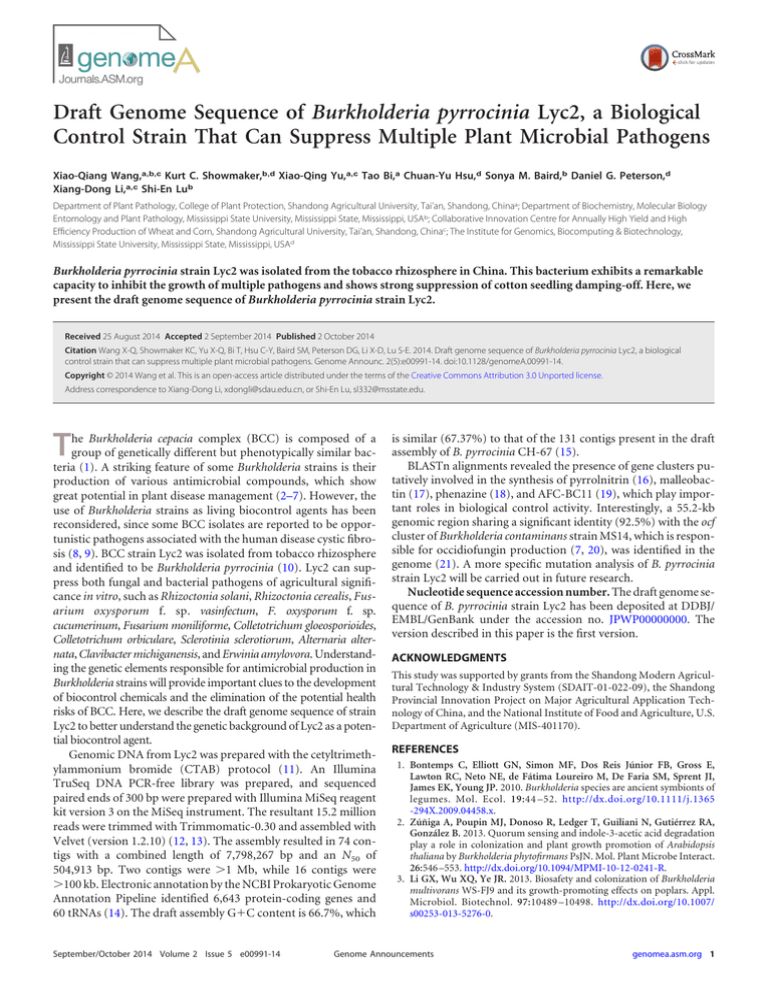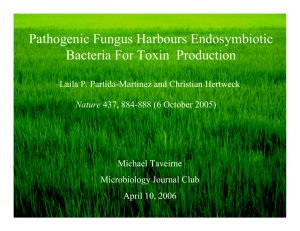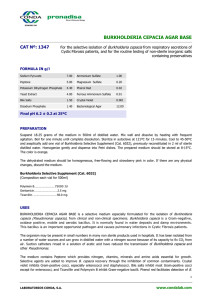Burkholderia pyrrocinia Control Strain That Can Suppress Multiple Plant Microbial Pathogens
advertisement

crossmark Draft Genome Sequence of Burkholderia pyrrocinia Lyc2, a Biological Control Strain That Can Suppress Multiple Plant Microbial Pathogens Xiao-Qiang Wang,a,b,c Kurt C. Showmaker,b,d Xiao-Qing Yu,a,c Tao Bi,a Chuan-Yu Hsu,d Sonya M. Baird,b Daniel G. Peterson,d Xiang-Dong Li,a,c Shi-En Lub Department of Plant Pathology, College of Plant Protection, Shandong Agricultural University, Tai’an, Shandong, Chinaa; Department of Biochemistry, Molecular Biology Entomology and Plant Pathology, Mississippi State University, Mississippi State, Mississippi, USAb; Collaborative Innovation Centre for Annually High Yield and High Efficiency Production of Wheat and Corn, Shandong Agricultural University, Tai’an, Shandong, Chinac; The Institute for Genomics, Biocomputing & Biotechnology, Mississippi State University, Mississippi State, Mississippi, USAd Burkholderia pyrrocinia strain Lyc2 was isolated from the tobacco rhizosphere in China. This bacterium exhibits a remarkable capacity to inhibit the growth of multiple pathogens and shows strong suppression of cotton seedling damping-off. Here, we present the draft genome sequence of Burkholderia pyrrocinia strain Lyc2. Received 25 August 2014 Accepted 2 September 2014 Published 2 October 2014 Citation Wang X-Q, Showmaker KC, Yu X-Q, Bi T, Hsu C-Y, Baird SM, Peterson DG, Li X-D, Lu S-E. 2014. Draft genome sequence of Burkholderia pyrrocinia Lyc2, a biological control strain that can suppress multiple plant microbial pathogens. Genome Announc. 2(5):e00991-14. doi:10.1128/genomeA.00991-14. Copyright © 2014 Wang et al. This is an open-access article distributed under the terms of the Creative Commons Attribution 3.0 Unported license. Address correspondence to Xiang-Dong Li, xdongli@sdau.edu.cn, or Shi-En Lu, sl332@msstate.edu. T he Burkholderia cepacia complex (BCC) is composed of a group of genetically different but phenotypically similar bacteria (1). A striking feature of some Burkholderia strains is their production of various antimicrobial compounds, which show great potential in plant disease management (2–7). However, the use of Burkholderia strains as living biocontrol agents has been reconsidered, since some BCC isolates are reported to be opportunistic pathogens associated with the human disease cystic fibrosis (8, 9). BCC strain Lyc2 was isolated from tobacco rhizosphere and identified to be Burkholderia pyrrocinia (10). Lyc2 can suppress both fungal and bacterial pathogens of agricultural significance in vitro, such as Rhizoctonia solani, Rhizoctonia cerealis, Fusarium oxysporum f. sp. vasinfectum, F. oxysporum f. sp. cucumerinum, Fusarium moniliforme, Colletotrichum gloeosporioides, Colletotrichum orbiculare, Sclerotinia sclerotiorum, Alternaria alternata, Clavibacter michiganensis, and Erwinia amylovora. Understanding the genetic elements responsible for antimicrobial production in Burkholderia strains will provide important clues to the development of biocontrol chemicals and the elimination of the potential health risks of BCC. Here, we describe the draft genome sequence of strain Lyc2 to better understand the genetic background of Lyc2 as a potential biocontrol agent. Genomic DNA from Lyc2 was prepared with the cetyltrimethylammonium bromide (CTAB) protocol (11). An Illumina TruSeq DNA PCR-free library was prepared, and sequenced paired ends of 300 bp were prepared with Illumina MiSeq reagent kit version 3 on the MiSeq instrument. The resultant 15.2 million reads were trimmed with Trimmomatic-0.30 and assembled with Velvet (version 1.2.10) (12, 13). The assembly resulted in 74 contigs with a combined length of 7,798,267 bp and an N50 of 504,913 bp. Two contigs were ⬎1 Mb, while 16 contigs were ⬎100 kb. Electronic annotation by the NCBI Prokaryotic Genome Annotation Pipeline identified 6,643 protein-coding genes and 60 tRNAs (14). The draft assembly G⫹C content is 66.7%, which September/October 2014 Volume 2 Issue 5 e00991-14 is similar (67.37%) to that of the 131 contigs present in the draft assembly of B. pyrrocinia CH-67 (15). BLASTn alignments revealed the presence of gene clusters putatively involved in the synthesis of pyrrolnitrin (16), malleobactin (17), phenazine (18), and AFC-BC11 (19), which play important roles in biological control activity. Interestingly, a 55.2-kb genomic region sharing a significant identity (92.5%) with the ocf cluster of Burkholderia contaminans strain MS14, which is responsible for occidiofungin production (7, 20), was identified in the genome (21). A more specific mutation analysis of B. pyrrocinia strain Lyc2 will be carried out in future research. Nucleotide sequence accession number. The draft genome sequence of B. pyrrocinia strain Lyc2 has been deposited at DDBJ/ EMBL/GenBank under the accession no. JPWP00000000. The version described in this paper is the first version. ACKNOWLEDGMENTS This study was supported by grants from the Shandong Modern Agricultural Technology & Industry System (SDAIT-01-022-09), the Shandong Provincial Innovation Project on Major Agricultural Application Technology of China, and the National Institute of Food and Agriculture, U.S. Department of Agriculture (MIS-401170). REFERENCES 1. Bontemps C, Elliott GN, Simon MF, Dos Reis Júnior FB, Gross E, Lawton RC, Neto NE, de Fátima Loureiro M, De Faria SM, Sprent JI, James EK, Young JP. 2010. Burkholderia species are ancient symbionts of legumes. Mol. Ecol. 19:44 –52. http://dx.doi.org/10.1111/j.1365 -294X.2009.04458.x. 2. Zúñiga A, Poupin MJ, Donoso R, Ledger T, Guiliani N, Gutiérrez RA, González B. 2013. Quorum sensing and indole-3-acetic acid degradation play a role in colonization and plant growth promotion of Arabidopsis thaliana by Burkholderia phytofirmans PsJN. Mol. Plant Microbe Interact. 26:546 –553. http://dx.doi.org/10.1094/MPMI-10-12-0241-R. 3. Li GX, Wu XQ, Ye JR. 2013. Biosafety and colonization of Burkholderia multivorans WS-FJ9 and its growth-promoting effects on poplars. Appl. Microbiol. Biotechnol. 97:10489 –10498. http://dx.doi.org/10.1007/ s00253-013-5276-0. Genome Announcements genomea.asm.org 1 Wang et al. 4. Lee KY, Kong HG, Lee SW. 2012. Identification of a gene encoding adenylate kinase involved in antifungal activity expression of the biocontrol strain Burkholderia pyrrocinia CH-67. Plant Pathol. J. 28:373–380. http://dx.doi.org/10.5423/PPJ.OA.08.2012.0124. 5. Kwak MJ, Song JY, Kim SY, Jeong H, Kang SG, Kim BK, Kwon SK, Lee CH, Yu DS, Park SH, Kim JF. 2012. Complete genome sequence of the endophytic bacterium Burkholderia sp. strain KJ006. J. Bacteriol. 194: 4432– 4433. http://dx.doi.org/10.1128/JB.00821-12. 6. Ellis D, Gosai J, Emrick C, Heintz R, Romans L, Gordon D, Lu SE, Austin F, Smith L. 2012. Occidiofungin’s chemical stability and in vitro potency against Candida species. Antimicrob. Agents Chemother. 56: 765–769. http://dx.doi.org/10.1128/AAC.05231-11. 7. Lu SE, Novak J, Austin FW, Gu G, Ellis D, Kirk M, Wilson-Stanford S, Tonelli M, Smith L. 2009. Occidiofungin, a unique antifungal glycopeptide produced by a strain of Burkholderia contaminans. Biochemistry 48: 8312– 8321. http://dx.doi.org/10.1021/bi900814c. 8. Workentine ML, Surette MG, Bernier SP. 2014. Draft genome sequence of Burkholderia dolosa PC543 isolated from cystic fibrosis airways. Genome Announc. 2(1):e00043-14. http://dx.doi.org/10.1128/ genomeA.00043-14. 9. Rosales-Reyes R, Aubert DF, Tolman JS, Amer AO, Valvano MA. 2012. Burkholderia cenocepacia type VI secretion system mediates escape of type II secreted proteins into the cytoplasm of infected macrophages. PLoS One 7:e41726. http://dx.doi.org/10.1371/journal.pone.0041726. 10. Yu XQ, Xi LJ, Liu YG, Li GW, Lan YF, Zhu XP, Li XD. 2007. Physio-biochemical characterization and molecular identification of Burkholderia cepacia isolate Lyc2 as a PGPR to cotton seedlings. Acta Phytopathol. Sinica 37:426 – 432. 11. Del Sal G, Manfioletti G, Schneider C. 1989. The CTAB-DNA precipitation method: a common mini-scale preparation of template DNA from phagemids, phages or plasmids suitable for sequencing. BioTechniques 7:514 –520. 12. Zerbino DR, Birney E. 2008. Velvet: algorithms for de novo short read assembly using de Bruijn graphs. Genome Res. 18:821– 829. http:// dx.doi.org/10.1101/gr.074492.107. 2 genomea.asm.org 13. Bolger AM, Lohse M, Usadel B. 2014. Trimmomatic: a flexible trimmer for Illumina sequence data. Bioinformatics 30:2114 –2120. http:// dx.doi.org/10.1093/bioinformatics/btu170. 14. Angiuoli SV, Gussman A, Klimke W, Cochrane G, Field D, Garrity GM, Kodira CD, Kyrpides N, Madupu R, Markowitz V. 2008. Toward an online repository of standard operating procedures (SOPs) for (meta) genomic annotation. Omics J. Integr. Biol. 12:137–141. http://dx.doi.org/ 10.1089/omi.2008.0017. 15. Song JY, Kwak MJ, Lee KY, Kong HG, Kim BK, Kwon SK, Lee SW, Kim JF. 2012. Draft genome sequence of the antifungal-producing plantbenefiting bacterium Burkholderia pyrrocinia CH-67. J. Bacteriol. 194: 6649 – 6650. http://dx.doi.org/10.1128/JB.01779-12. 16. Jayaswal RK, Fernandez M, Upadhyay RS, Visintin L, Kurz M, Webb J, Rinehart K. 1993. Antagonism of Pseudomonas cepacia against phytopathogenic fungi. Curr. Microbiol. 26:17–22. http://dx.doi.org/10.1007/ BF01577237. 17. Yang H, Kooi CD, Sokol PA. 1993. Ability of Pseudomonas pseudomallei malleobactin to acquire transferrin-bound, lactoferrin-bound, and cellderived iron. Infect. Immun. 61:656 – 662. 18. Morris MB, Roberts JB. 1959. A group of pseudomonads able to synthesize poly-beta-hydroxybutyric acid. Nature 183:1538 –1539. http:// dx.doi.org/10.1038/1831538a0. 19. Kang Y, Carlson R, Tharpe W, Schell MA. 1998. Characterization of genes involved in biosynthesis of a novel antibiotic from Burkholderia cepacia BC11 and their role in biological control of Rhizoctonia solani. Appl. Environ. Microbiol. 64:3939 –3947. 20. Gu G, Smith L, Liu A, Lu SE. 2011. Genetic and biochemical map for the biosynthesis of occidiofungin, an antifungal produced by Burkholderia contaminans strain MS14. Appl. Environ. Microbiol. 77:6189 – 6198. http://dx.doi.org/10.1128/AEM.00377-11. 21. Altschul SF, Madden TL, Schäffer AA, Zhang J, Zhang Z, Miller W, Lipman DJ. 1997. Gapped BLAST and PSI-BLAST: a new generation of protein database search programs. Nucleic Acids Res. 25:3389 –3402. http://dx.doi.org/10.1093/nar/25.17.3389. Genome Announcements September/October 2014 Volume 2 Issue 5 e00991-14



